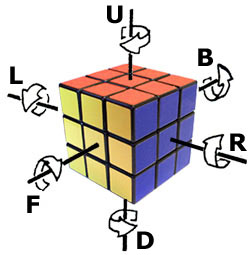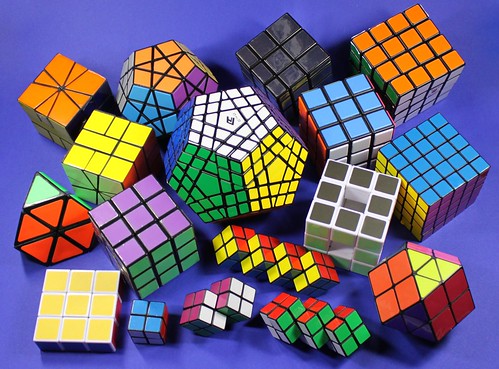Hi guys.
Ready to finish your cube? I bet you are!
Here we are guys. In less than 10min you'll probably have your first Rubik's Cube solved.
The last layer is the hardest part of the solving. Therefore you may have some difficulties at the beginning, because the algorithms have to be applied wisely. It's not only about blindly applying an algorithm a case! In the method that we use, solving the last layer is broken down into four steps: making a yellow cross, setting the cross correctly, placing the corners, and orienting them.
Let's start!
__________________________________________
Step 1: Yellow cross
The purpose is simple: you have to make a yellow cross on the last face, as we did for the very first one. For the moment, we don't care whether the edges are in the right place or not. We will place them in the second step! Don't you mind the corners either. Some of them may already be set in the right place, but don't be afraid to remove them, we will set them all later. Focus on the four edges!

The lateral color of the edges is not important!
Two algorithms to learn here, and they are very similar. They are described on the pictures below. To interpret them correctly, please notice that these pictures only represent the upper face, and not the one you have in front of you!
Case 1 : Case 2 : Purpose
F U R U' R' F' F R U R' U' F'
TIP: You will always find an even number of yellow edges on the upper face : 0,2 or 4. This can be mathematically proofed. Therefore, the 2 cases above are the only one you have to remember! If none of the yellow edges are on top, just do the two algorithms in a row to complete your cross. If 4 edges are already on top, that means your cross is already done!
Step 2 : Placing the cross
The purpose is to match the cross with the corresponding lateral faces :
You will have to move the edges to put them in the right place, but without breaking up the cross. Therefore, we will use an algorithm that make the edges switch places. We will apply this algorithm until the cross is correct.
Here is how the algorithm works. The edge in front of you will stay in place, and the three others will turn clockwise, like this :
R U2 R' U' R U' R' (*)
(*) U2 = U U
TIP: Try to be clever in order to gain time! Turn the upper face wisely until an edge is correctly placed, and then apply the algorithm with the correct edge in front of you. Try to anticipate the result of the algorithm, this will save you from doing it a hundred times for nothing. With practice you'll notice that it is possible to do it in one!
Step 3: Placing the corners
The purpose of this step is to put all the corners in the right place: the yellow/red/green corner between the yellow, the red and the green faces, etc. But we will not mind the orientation of the corners. Therefore, this is a correctly-placed corner :
The algorithm that we use works the same as the previous one. It will make the corner in front of you on the right stay in place, and the three others turn clockwise:
L' U R U' L U R' U'
Apply the algorithm until your corners are all in the right place!
TIP: You will have to think a lot to complete this step. Anticipate! It is always possible to set the four corners with just two wisely-applied algorithms.
Step 4 : Orienting the corners
Here we are, last step! Your heart should be beating right now, we're approaching the end of it.
In this last step, there is only one algorithm to learn. It makes the two corners on your right spin around, in such a way as to put the external color on the top :
( R U2 R' U' R U' R' ) ( L' U2 L U L' U L )
Tip: The algorithm is made of the one that we learned to place the yellow cross, united with his symmetrical twin. He's therefore easy to remember. Sometimes you will have to repeat this algorithm many times on several corners. It may seem tedious, but it is worth it, because at the end of it, your cube is solved!
________________________________________
So guys, did you manage to get it done? If yes you did a really good job!
I sincerely thank you for having read all this, and I promise to teach you faster methods as soon as possible! Because I know that once we really own this method, it becomes quickly boring, because we know that we often repeat the same algorithms, and that we could save time by not doing it. The advanced method that I use is not boring at all, I'm sure that you will love it!
So stay tuned, and also don't forget to subscribe and to give your opinion in the comment section below. See you soon guys!






